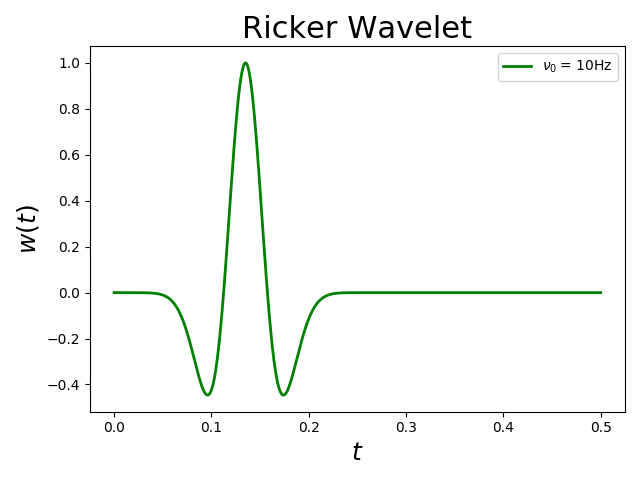1.1. Seismic Sources¶
 is the force function or source function in the above equation. We need to define it first.
is the force function or source function in the above equation. We need to define it first.
We define our source functions as  , where
, where  is the time profile,
is the time profile,  indicates that we will use point sources, and the source location is
indicates that we will use point sources, and the source location is  .
In real world applications, the time profile is not known and is estimated as part of the inverse problem. However, it is common to model source signals with the negative second derivative of a Gaussian, also known as the Ricker Wavelet:
.
In real world applications, the time profile is not known and is estimated as part of the inverse problem. However, it is common to model source signals with the negative second derivative of a Gaussian, also known as the Ricker Wavelet:

where  is known as the characteristic or peak frequency (in Hz), because the magitude of
is known as the characteristic or peak frequency (in Hz), because the magitude of  ‘s Fourier transform
‘s Fourier transform  attains its maximum at that frequency.
It is also important that this function is causal (
attains its maximum at that frequency.
It is also important that this function is causal ( for
for  ), so we introduce a time shift
), so we introduce a time shift  ,
,

Problem 1.1
Write a Python function ricker(t, config) which implements the Ricker
Wavelet, taking a time t in seconds and your configuration dictionary.
This function should assume that your configuration dictionary has a key
nu0 representing the peak frequency, in Hz. Your function should
returns the value of the wavelet at time t.
You can guarantee causality by setting  for
for
 , the standard deviation of
the underlying Gaussian. You may also want to implement an optional
threshold to prevent excessively small numbers.
, the standard deviation of
the underlying Gaussian. You may also want to implement an optional
threshold to prevent excessively small numbers.
Plot your function for  at
at  and label the plot.
and label the plot.
# In fwi.py
def ricker(t, config):
nu0 = config['nu0']
sigmaInv = math.pi * nu0 * np.sqrt(2)
cut = 1.e-6
t0 = 6. / sigmaInv
tdel = t - t0
expt = (math.pi * nu0 * tdel) ** 2
w = np.zeros([t.size])
w[:] = (1. - 2. * expt) * np.exp( -expt )
w[np.where(abs(w) < 1e-7)] = 0
return w
# Configure source wavelet
config['nu0'] = 10 #Hz
# Evaluate wavelet and plot it
ts = np.linspace(0, 0.5, 1000)
ws = ricker(ts, config)
plt.figure()
plt.plot(ts, ws,
color='green',
label=r'$\nu_0 =\,{0}$Hz'.format(config['nu0']),
linewidth=2)
plt.xlabel(r'$t$', fontsize=18)
plt.ylabel(r'$w(t)$', fontsize=18)
plt.title('Ricker Wavelet', fontsize=22)
plt.legend();
